What's in Your Wallet? – African Iron Currencies
PRIMITIVE - Friday, August 08, 2014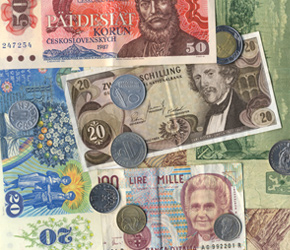 |
|
By Misaki Imagawa
Edited by Glen Joffe
Traveling in Switzerland is ridiculously easy – a few hours on the road and you’re already in another country. I grew up in Switzerland and as a child my family traveled all the time. On one particular trip across several countries we ended up in Munich, enjoying a brunch stacked with sausages, potatoes and beer. When we were finished I helped my father count colorful Deutsche Mark bills to pay the check, and seeing my interest, he gave me some of the spare change in his pocket. I was extremely proud that I could point out the Austrian Schillings and Italian Liras mixed in with the rest of the money. Of course, this was before the Euro existed.
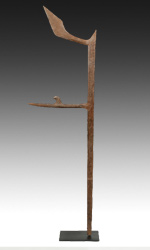 |
|
Much to my displeasure, after brunch we toured the art galleries behind the Royal Court Gardens. At that time, I wasn’t a fan of art. I preferred to be outside, especially when the weather was nice; however, one particular gallery window drew my otherwise unimpressed attention. Behind the glass window were tall metal objects that looked like superhero weapons in my tomboyish mind. They were huge; taller than me, but thin and shaped in fascinating designs. I insisted we go inside, and to my delight I found even more of them displayed. A man from the gallery explained that these were forms of African currency. “Like the Deutsche Mark?” I asked. “Yes, except these are more than just money,” he replied. “These are objects of prestige.”
As it turned out, the function of this currency went far beyond the day-to-day transactions we normally associate with money. These were highly symbolic objects, often representing status and social hierarchy. Some of the currency was shaped as elaborate ornaments, worn by women to indicate their rank within a family or by leaders to display power. Other currency looked like farming tools and weapons, although they were typically too large or heavy for practical use. The impressive scale of some of these currencies was not solely for the sake of aesthetics. It turned out; in some cases size was directly proportional to value. After all, these currencies could be melted down and re-forged into real weapons or tools if needed, giving them intrinsic value.
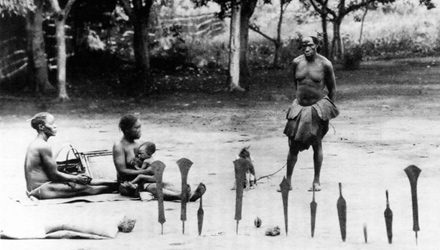 |
The Perfect Form (Roberto Ballarini, 2009) Photo credit: Herbert Lang |
Before currencies made from iron became popular in Africa, other materials of value were used for trade. For example, cowry shells imported from the Maldives in the Indian Ocean were considered highly precious and are still regarded as symbols of prestige to this day. However, as the value of iron increased, it was the metal currencies that were used for larger, more important investments such as the purchase of livestock or land. They were also used during matrimony as a bride price – compensation to the bride’s family for losing a daughter. No pennies were pinched – or in this case, iron currency - when it came to acquiring wives! By the 1960s most African countries had adopted paper money and the tribal currencies of old became purely works of art. Since then, they have become highly collectible, especially among Western collectors who have valued them as both ethnographic curiosities with a rich cultural history and distinctive sculpture.
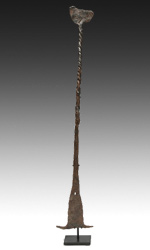 |
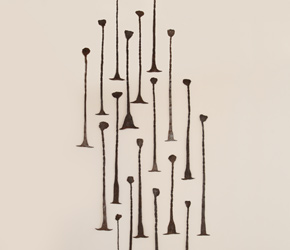 |
When it comes to iron currency from Africa, there is a wide variety of sculptural forms. Each tribe forged their own particular style that could further vary village by village. Consequently, African forged iron currencies are named after the tribes who made them, the places they come from, and sometimes, if knowledge is absent, the forms they represent. For example, names like Mbole, Gere, Dan, Igbo and Yoruba refer to tribes; Kinshasa is a place, and knife currency is a form. All are specific names for individual types of currency.
African iron currency is uniquely crafted and visually pleasing. In essence, each piece is one-of-a-kind. Many of the forms have an aesthetic that references modern art. For example, Mbole currency from the Republic of Congo has a simple, uniformly rounded design with a hole in the center. Although it was designed to be worn around the ankle, when seen as a complete collection it has the appearance of an installation that could be seen at any Museum of Modern Art. PRIMITIVE recently mounted such an installation. Another form that is equally modern is known as Kissi Pennies. These look like skinny anthropomorphic figures. Ganged together they feel like a contemporary community. PRIMITIVE also mounted an installation of Kissi Pennies too. I can say with certainty, after my trip to Munich, Marks and Schillings started looking awfully boring to my eyes. The African iron currencies I encountered back then were awe-inspiring to behold. Now, they are inspiring awe worldwide. They are testament that once prestige is earned it never fades.
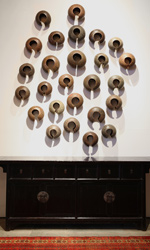 |
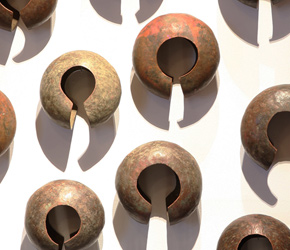 |
Download this Article: What's in Your Wallet.pdf